Carnaval is what I would refer to as a reactionary religious celebration. In other words, while Carnaval itself is not particularly religious, it wouldn’t exist if it weren’t for another celebration which is. The holiday that gave birth to Carnaval is Ash Wednesday, marking the beginning of the 40 day Lenten period of traditional fasting, sacrifice and devout observation of the miracle of Jesus’ transubstantiation.
The prospect of all that fasting and quiet meditation led some Catholics, long ago, to get their kicks in before their 40 day purge. The idea of a party appealed to enough people for these binges to become annual celebrations of their own, manifesting in the French culture of New Orleans as Mardi Gras, or Fat Tuesday, so named for the consequence of all the eating and drinking the day before Lent. In many parts of Latin America, we have Carnaval, taking the idea of Mardi Gras a step further. After all, why celebrate for just a day? Carnaval is traditionally recognized as a weeklong celebration, but my experience has been that it starts a little after New Year’s Day and keeps getting bigger and bigger. And even if you’re not Catholic, everyone gets to play, usually whether they like it or not.
My first experience with Carnaval was a mysterious splash of water behind me as I was walking down the streets of Cuenca. I looked around, but couldn’t tell where it came from. There was no one around, just a wet spot on the ground. I shrugged my shoulders and kept on walking. In the coming weeks, however, it became very clear what had narrowly missed me. With a disturbing frequency, I became witness to many personal attacks executed in broad daylight. Often the perpetrators operated from motor vehicles, with a variety of weaponry. Their targets were always the same: unsuspecting passersby. The more unsuspecting, the better. Couples and gringos, wrapped up in their own worlds, were the most vulnerable.
A case study: a group of five CEDEI teachers are walking down a quiet street, too involved in their own conversation to take notice of the attackers waiting, plotting, above. Then, comes the strike, all at once: uncounted water balloons, some off-target, but some bound to connect. Amid the screams and confusion from below, drifts down the devilish laughter of four boys from their upstairs balcony, already armed with another battery of balloons, dripping, swollen and sagging from their hands.
A grim portrait. And there is little we possess in our arsenal of defence, save our own wits. The playing of Carnaval is technically illegal in Cuenca, but as I also witnessed, the police themselves are complicit. One day an armored car was driving slowly down Gran Columbia, a main thoroughfare in Cuenca’s center. Through the slot in the side of the vehicle, designed for visibility and protection, jutted the barrel of a watergun, blasting distracted pedestrians with precision.
CEDEI teachers, especially women, seemed to be particularly obvious targets. A group of three of them were walking through parque de la madre one day, enjoying ice cream cones. A driveby hurling of a water balloon left one of them wet in the face, her cone empty, and her beloved scoop of cookies n’ cream laying uselessly on the ground. Que pena!
Some teachers, perhaps traumatized and desperate from too many drenchings, choose to join rank and buy some innocent-looking little rubber balloons at the corner store, turn them into weapons at the nearest sink, and mount their own ambushes. The rest of us opt to stay on the defensive. Which is very challenging, especially considering our own places of work are crawling with the most common source of attack, namely, cuencano teenagers. I found that as long as I keep my head up, they stay their attacks. Sometimes, out of respect and fear for those that hold the gradebooks, the group of kids ubiquitously hanging around the front door of CEDEI have the courtesy to ask me if they can throw a balloon at me. Nope, sorry.
Nonetheless, I chose not to take up arms, deciding that if I wanted to stay dry, I couldn’t in good conscious add to the water level. That said, I did toss one at a few CEDEI preschool teachers as they walked past our BBQ, but I would’ve done that whether it was Carnaval or not.
On the street, I developed a strategy for my self-defense. I walk around with my eyes lifted upward to the terraces that lie on the rooftops of nearly every building in town. I noticed that even if there were kids upstairs from me, they wouldn’t throw if they knew I saw them, because then I’d just dodge out of the way before the balloon reached me. I stroll slowly, confidently, choosing one-way streets where the oncoming traffic comes in front of me, lessening the chance of sneak attacks from behind. Overall, I would venture to say that my strategem was successful, seeing as how I managed to stay dry throughout my entire Carnaval experience in Cuenca.
But this fortune did not carry through to Tena. Perhaps it was due to the general laid-back lifestyle in Cuenca that helped keep me dry, or that the last days of Carnaval whip the revelers into a heightened frenzy. But we weren’t in Tena for more than an hour before getting soaked. Water balloons, water guns, buckets, hoses. Kids on rooftops, kids with big barrels full of water in the streets, splashing it everywhere. Don’t stand around and laugh at how wet you are or you’ll just keep getting wetter. Even on the bus ride to Tena, kids waited along the sides of the road, ready to hurl a balloon in any window cracked open for relief from the humidity inside the bus. Fortunately, our hotel was several blocks from the main drag, and despite the late hour, the jungle sun had just about dried us off in the calm of the walk on the backstreets.
The next day we wandered out into town, where we met the aforementioned spider monkey.
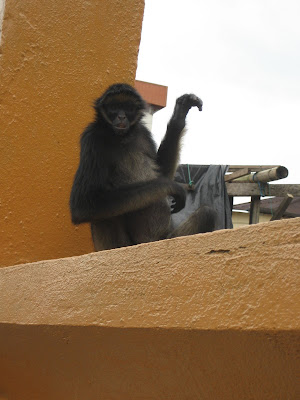
He seemed, judging from his ample belly, very comfortable living in town, and he probably was. If pea-brained pigeons can make a living in cities around the world, an animal with thumbs and a prehensile tail ought to do pretty well. In fact, smaller villages such as Misuhualli, deeper still into the Amazon, are crawling with monkeys who have adapted to life in towns catering to tourists by stealing their drink bottles as they sit in the town square. Rumor has it these monkeys have developed a habit for the caffeine in soda and know where to get their fix. They don’t have any trouble opening the cap, and once they have the bottle they go high up a tree where you’ll never get it back.
This monkey, though, was very calm, albeit alternating repeatedly from sitting upright to adopting the more casual pose it struck in the first picture. It also made lots of funny faces for no particular reason, and made all kinds of odd gestures with its hands. After we had communed briefly with him, we walked down to the Rio Tena, which divides downtown from the more commercial district.
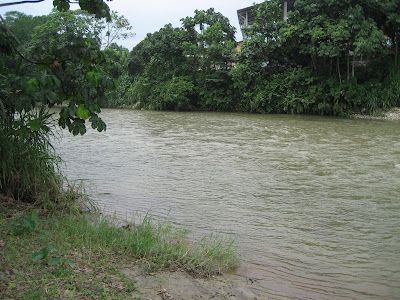
The river was wide and calm, flowing slowly down to the nearby Rio Napo, which by and by is a tributary to the Amazon itself. As such, any water here, just about 250 miles from the Pacific Ocean, will ultimately drain all the way to the Atlantic. The Sierra region of Ecuador straddles the continental divide, and any water to the east of it, no matter how close to the Pacific it might fall, will flow inexorably in the other direction.
At the confluence of the Rio Tena and the smaller Rio Pano (not to be confused with the much larger Rio Napo) is a park called La Isla, a small zoo featuring several jungle creatures for the enjoyment of tourists who will never venture any deeper into wilds. And, for some reason, an ostrich. Also in the menagerie lived a few monkeys, most of them running free. One of them, of a much smaller species than the spider monkey we met in town, was very friendly:
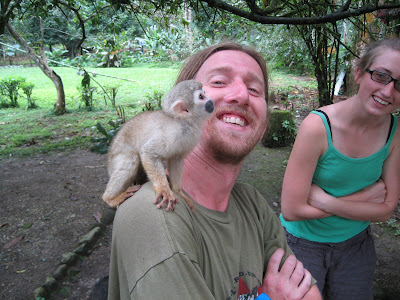
He spent several minutes crawling around my neck, head, shoulders, back, arms, and water bottle, doing his best to chew his way through the lid. He never tried using his hands, which were, admittedly, more like paws, and opted instead to use his teeth like a common animal. It’s little guys like this that help bridge the evolutionary gap between primate and rodent, probably. His small size proved to be a disadvantage, as shortly after he leapt to a tree nearby, a much larger monkey decided he wanted to take him away. There was little the small monkey could do, as the bigger spider monkey kept a firm grip on his tail and wouldn’t let him go. After wrestling for a little while, finally the big monkey just picked him up and hauled him off, in footage resembling a candid sasquatch sighting:
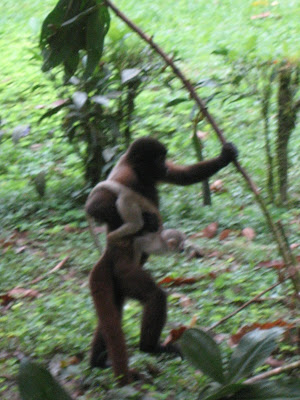
For a moment, it seemed like the small monkey might have been able to make his escape, but the spider monkey once again seized him by the tail and climbed up into a tree. Once amongst the branches above, the little one made his last bid for freedom, but ultimately, it was the tail, that enigmatic fifth limb lost to us higher primates, which was his undoing. In a dramatic display of agility and determination, the spider monkey, dangling from his own, got hold of the white one’s tail as he dropped wildly, pulled him up into the canopy, and that was the last we saw of him.
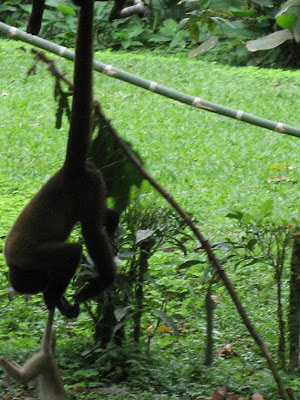
Crazy monkeys. So like us.
Later that afternoon, we went for beers at a little grass hut doubling as a bar. Fortunately we were able to find seats under the thatched canopy of the hut, as the sky soon opened up into a mighty downpour that lasted for hours. The three of us were impressed by the intensity and duration of the rain, but the locals just shrugged and calmly waited it out, sucking down Pilseners to pass the time. That seemed like a fine idea to us, and once the rain subsided we were ready to take in more of the local color.
We walked over to the town square, which in most Latin American towns I’ve visited is given over to an urban park with stone walkways, benches and colorful flora. The people of Tena opted to build an amphitheater in theirs, and that night, being one of the last nights of Carnaval, there was a concert series with several singers and bands performing. There was also a lot of carioca.
Not to be confused with karaoke, which you’ll hear about later. Carioca is the name that somehow got applied to those cans of toxic, colorful foam that kids love to play with. Ecuador must be the world’s largest consumer of carioca, judging from the quantity of it that circulated even the small town of Tena. A can, once in the hands of a child, lasted about 10 seconds, as he would immediately empty it all over whoever was sitting next to him. The sight of little kids running around with an enormous glob of neon pink foam stuck to his head and face was a common one, and, being the only gringos anywhere to be found, we were easy targets.
It began with the occasional spurt of foam from behind, higher up in the grandstand. At first we all laughed, but bit by bit these infrequent blasts came more often, and in larger doses. We quickly realized that we were surrounded by armed children who were rapidly losing their inhibition to lay seige on foreigners. The first few shots appeared to be to test their limits, and when neither the gringos nor their parents did anything to stop them, they began to thoroughly enjoy attacking their unarmed victims. We got tired of being easy targets and bought a couple of cans. Holding one, I waited for a kid to spray me. Then I spun around and let him have it, dousing him good on the side of his face and then even better on the back of his head as he turned tail.
Unfortunately, now that we could and did defend ourselves, the last vestige of self control came down and we were fully assaulted by children on all sides. We fought back well, turning a few on their heels, but in the end it was a war of attrition and our limited arsenal was no match for their numbers. An image of the fallout:
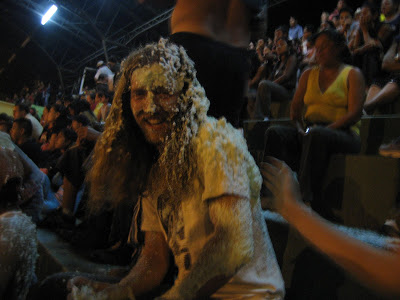
A look at the crowds around us well illustrates how we were targeted. Only those people who had the misfortune to sit in the crossfire are wearing foam, and a look at the faces of the audience reveals a disturbing indifference to the aggression. My theory is that years of this sort of spectacle have rendered the locals numb to the diablitos (as these little kids are locally referred to during Carnaval) and their shenanigans. As for us, we drained our cans on a few more grade-schoolers and went home. Along the way, the foam that covered us melted in the light rain, into a bizarre and strange smelling film that, thankfully, rinsed off easily in the shower. We all decided that we’d much rather get hit in the face with a water balloon. For our last full day in Tena we went whitewater rafting on the Rio Napo. The river rapids were frequent but mellow, never once threatening to flip our raft. In order to give us more bang for our buck, our river guide chose to take a few extreme measures to make sure at least a few of us got wet. The first was his offer of River Rodeo, and he insisted on a volunteer before he would explain the rules.
Emboldened by the calm waters, I raised my hand, and was promptly ordered to sit up on the nose of the raft with my feet dangling over the front of the rubber boat. All I had to hold onto was a small metal ring which I managed to get a couple of fingers through, and I slid around on the wet nose of the boat with every bump of a rock. We went through some rapids, admittedly small ones, and I got through them without getting bucked off the raft. Even I was able to toss one arm into the air for awhile.
Our guide seemed disappointed and asked for another volunteer. Vince, one of my fellow travelers, got the honor and parked himself up front. Another ride through the rapids left him perched safely on the nose of the boat as well, and our guide, a burly but athletic Ecuadorian raised in El Oriente, jumped up to the front of the boat and with a sudden shove to the back, Vince disappeared into the river.
A few seconds later he emerged alongside the raft and we hauled him back in. We all were wearing lifejackets and helmets, and the river so wide and slow that Vince was never in any danger, even if he hadn’t been a trained swimmer. The waters are so mellow and gentle between rapids, in fact, that during a particularly long stretch of smooth sailing our guide proposed another game.
This time, he ordered us all to the back of the boat, and, running a rope through the metal ring up front, joined us in the stern and with a pull of the rope, lifted our raft so that it was floating vertically down the river, nose straight up in the air and us hanging on to whatever we could to avoid flopping out of the back of the raft and taking the whole thing upside down on top of us. For a few seconds I wondered if we might try to go through the rapids this way, but long before any came along he let the boat smack down into its proper position in the water and we got back into our places.
I’ve heard of some other jungle rafting experiences that have left rafters spinning violently in class 4 rapids under their raft, getting dashed against rocks as they struggled to swim up along side a boat equally out of control in the whitewater. In light of those kinds of stories, I was glad most of our excitement was manmade and under control, even as I had hoped for a little bit wilder of a time going through the rocks.
That night we had our last dinner in Tena, at a restaurant open late. While we were eating, we couldn’t help but notice the horrible singing that constituted the music we were listening to. Could that possibly be a professional singer? A trip to the bathroom by Lauren revealed a karaoke bar on the other side of the building, and we decided to check it out. The song list was rife with love ballads in Spanish, which one girl was systematically crooning one by one in a broken cadence of long, high notes.
An exhaustive examination of the list revealed one song we all knew: Another one bites the dust, by Queen. I was a little skeptical of this choice, because while we all knew the refrain, there were a lot of other words in that song I’d never bothered to pay attention to, but we came to sing, and this was our only option. One equally shameful display of virtuosity later, and jobs done, we finished our beers and walked out to a resumed performance by the same girl who’d been singing, all night long.
There was something poetic about songs sung so badly but so proudly, late at night at what may have been the only karaoke bar in the province. Amid the songs of jungle birds and insects that make the real music of the Amazon, those off-key lyrics are a fine example. Human beings will never be able to approach the beauty of the jungle with anything that we carve out of it. Right now the only sizable comunities in El Oriente of Ecuador hug the bottom of the eastern cordillera. Further east is the wild jungle, wilder and wilder the deeper you go. With all the oil still waiting quietly under much of it, I hope it stays that way a long, long time.
















